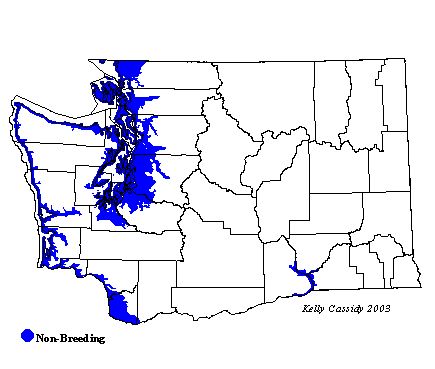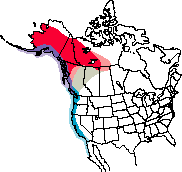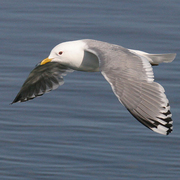Short-billed Gull
The Washington representatives of this family can be split into two groups, or subfamilies. The adaptable gulls are the most familiar. Sociable in all seasons, they are mainly coastal, but a number of species also nest inland. Many—but not all—are found around people. Gulls have highly variable foraging techniques and diets. Terns forage in flight, swooping to catch fish or insects. They dive headfirst into the water for fish. Although they are likely to be near water, they spend less time swimming than gulls.
General Description
The smallest North American white-headed gull, the Short-billed Gull is commonly described as having a 'gentle' or 'dove-headed' look. The Short-billed Gull has typical gull-like plumage--slate-gray back and wings, a white head, tail, and body, and black wingtips with white spots. The beak and legs are yellow. In breeding plumage, the Short-billed Gull has a clean white head, a dark eye, and a solid yellow bill without markings. In non-breeding plumage, its head is smudged with brown, the red eye-ring is absent, and the bill is partially dark. Juveniles are varying degrees of mottled brown interspersed with white and gray.
Habitat
In winter, the Mew Gull inhabits coastal waters, and is commonly found in estuaries, river mouths, and freshwater ponds close to the shore. Summer habitat is concentrated around northern lakes. This species is not common at garbage dumps in any season and is seldom found offshore.
Behavior
Mew Gulls can be found with other gulls at abundant food sources, such as spawning areas and along tidal convergence zones. Like many gulls, the Mew Gull uses a variety of foraging techniques, obtaining food while walking, wading, swimming, or flying. It often feeds in fields and at sewage ponds. The Mew Gull sometimes carries a hard-shelled mollusk into the air and drops it on rocks or pavement to break it open.
Diet
Mew Gulls are omnivores whose diet varies with the season. On their breeding grounds, Mew Gulls eat mostly insects, which they often catch in mid-air. In coastal areas during the non-breeding season, small fish, crustaceans, and mollusks make up the majority of the diet. Other marine creatures, earthworms, small rodents, young birds, eggs, carrion, refuse, grain, and berries round out the diet of this opportunistic species.
Nesting
Breeding in small colonies or isolated pairs, Mew Gulls nest on high ground near water, or on top of a stump, or in a dense spruce up to 20 feet off the ground. Mew Gulls in Europe have been known to nest on gravel rooftops. When the nest is on the ground, it is a shallow scrape lined with grass. Nests built in trees are usually shallow cups of twigs and grasses. Both sexes help build the nest and incubate the 3 eggs for about 4 weeks. The young from nests built on the ground may leave the nest after a few days, but stay close by. The young in nests built in trees stay in the nest for a longer period. Both parents help feed the young, which fledge at about 4 weeks of age.
Migration Status
Inland breeders, Mew Gulls migrate directly to the coast, and disperse south from there. They first start appearing along the coast in late July, and numbers increase gradually through the fall. The height of the migration in the Northwest is from October to December. Migration back to the breeding grounds in the spring begins in March and continues through May.
Conservation Status
Numbers appear to be stable since Mew Gulls seem to benefit from human activities.
When and Where to Find in Washington
Mew Gulls are not known to breed in Washington, but breeding records exist from southern British Columbia, so breeding in Washington is a possibility. They are common all along the Pacific Coast from August to early May, and a rare visitor to eastern Washington from mid-September to mid-November. Groups of Mew Gulls can be found in agricultural fields along the lower Columbia River, and at the mouth of the River during the spring smelt runs in March.
 Abundance
Abundance
| Ecoregion | Jan | Feb | Mar | Apr | May | Jun | Jul | Aug | Sep | Oct | Nov | Dec |
|---|---|---|---|---|---|---|---|---|---|---|---|---|
| Oceanic | ||||||||||||
| Pacific Northwest Coast | C | C | C | C | U | U | C | C | C | C | ||
| Puget Trough | C | C | C | C | U | R | U | C | C | C | C | |
| North Cascades | R | R | R | R | ||||||||
| West Cascades | U | U | U | U | R | R | U | U | U | |||
| East Cascades | R | |||||||||||
| Okanogan | ||||||||||||
| Canadian Rockies | ||||||||||||
| Blue Mountains | ||||||||||||
| Columbia Plateau | R | R | R | R | R |
Washington Range Map

North American Range Map


Family Members
 Laughing GullLarus atricilla
Laughing GullLarus atricilla Franklin's GullLarus pipixcan
Franklin's GullLarus pipixcan Little GullLarus minutus
Little GullLarus minutus Black-headed GullLarus ridibundus
Black-headed GullLarus ridibundus Bonaparte's GullLarus philadelphia
Bonaparte's GullLarus philadelphia Heermann's GullLarus heermanni
Heermann's GullLarus heermanni Black-tailed GullLarus crassirostris
Black-tailed GullLarus crassirostris Short-billed GullLarus canus
Short-billed GullLarus canus Ring-billed GullLarus delawarensis
Ring-billed GullLarus delawarensis California GullLarus californicus
California GullLarus californicus Herring GullLarus argentatus
Herring GullLarus argentatus Thayer's GullLarus thayeri
Thayer's GullLarus thayeri Iceland GullLarus glaucoides
Iceland GullLarus glaucoides Lesser Black-backed GullLarus fuscus
Lesser Black-backed GullLarus fuscus Slaty-backed GullLarus schistisagus
Slaty-backed GullLarus schistisagus Western GullLarus occidentalis
Western GullLarus occidentalis Glaucous-winged GullLarus glaucescens
Glaucous-winged GullLarus glaucescens Glaucous GullLarus hyperboreus
Glaucous GullLarus hyperboreus Great Black-backed GullLarus marinus
Great Black-backed GullLarus marinus Sabine's GullXema sabini
Sabine's GullXema sabini Black-legged KittiwakeRissa tridactyla
Black-legged KittiwakeRissa tridactyla Red-legged KittiwakeRissa brevirostris
Red-legged KittiwakeRissa brevirostris Ross's GullRhodostethia rosea
Ross's GullRhodostethia rosea Ivory GullPagophila eburnea
Ivory GullPagophila eburnea Least TernSternula antillarum
Least TernSternula antillarum Caspian TernHydroprogne caspia
Caspian TernHydroprogne caspia Black TernChlidonias niger
Black TernChlidonias niger Common TernSterna hirundo
Common TernSterna hirundo Arctic TernSterna paradisaea
Arctic TernSterna paradisaea Forster's TernSterna forsteri
Forster's TernSterna forsteri Elegant TernThalasseus elegans
Elegant TernThalasseus elegans

